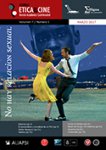The analysis of a film and psychoanalysis
DOI:
https://doi.org/10.31056/2250.5415.v7.n1.19719Keywords:
Film analysis, Cinematography, Psychoanalysis, Image-MovementAbstract
From a psychoanalytical point of view, the cinematographic art can be understood – most of the time- either from the logic of applied psychoanalysis or as isomorphic terms. This limits the contribution that the combination of film and psychoanalysis can be made when both those fields are given recognition in their power and singularity. The purpose of this article is to identify what is revealed as essential in an investigation process to make film analysis the most useful as possible. From an early time, Walter Benjamin noticed that both psychoanalysis and film had opened fields of the senses that, up until then, could not be seen or heard; and that both of these fields, sight and sound combined, could be very powerful. Cinematographic language - when recognized in its full potential – can capture the effects of reality like no other material can. Because of this, our hypothesis is to consider that bonding the psychoanalytical point of view with the cinematographic point of view can open a “double focal distance”. These two focal distances, when they converge together, tend to bond what can be seen with what can´t be seen; the invisibility of the unconscious problematic, with the visibility of image and movement.References
Assoun, P. L. (2009) «Traité de l’œuvre psychanalytique» in Dictionnaires des œuvres psychanalytiques, París, PUF, pág. 81. El trabajo realizado por Paul-Laurent Assoun sobre las metáforas freudianas es edificante al respecto (págs. 81 a 109).
Benjamin, W. (1939) «L’œuvre d’art à l’époque de sa reproductibilité technique in Œuvres III, Paris, Gallimard, 2000. (En español: W. Benjamin, La obra de arte en la época de su reproductibilidad técnica, en W. Benjamin, Discursos Interrumpidos I, Taurus, Buenos Aires, 1989]. https://monoskop.org/images/9/99/Be...)
Bergman, I. (2001) Laterna magica, París, Folio, págs. 12-13.
Bouyer, P.J y Bouyer, S.(2002). «Cinéma et psychanalyse», in Mijolla de, A., (ed) Dictionnaire international de la psychanalyse, París, Calmann Lévy, p. 325.
Dadou, R. (s/d). Cinéma, psychanalyse et politique, París, Séguier, pág. 53.
Debord, G. (1967), La Société du spectacle, París, Folio, 1992. [En español: G. Debord, La sociedad del espectáculo, in Revista Observaciones filosóficas, Madrid 1987](http://www.observacionesfilosoficas...)].
Deleuze, G. (1983) L’image-mouvement, París, Minuit. [En español: G. Deleuze, La imagen-movimiento. Estudios sobre cine 1, Buenos Aries, Paidós, 1984].
Deleuze, G.; Guattari, F. (1980) Mille Plateaux, París, Editions de Minuit.
Deleuze, G. y Guattari, F. (1993) ¿Qué es la filosofía?, Anagrama, Barcelona.
Kyrou, A.; Bunuel, L. (1962) CINEMA D’AUJOURD’HUI No: 4. París, Seghers.
Freud, S. (1907) Les délires et les rêves dans la Gradiva de Jensen, París, Gallimard, 1990, p. 141.
Freud, S. (1916-17). Introduction à la psychanalyse, París, Payot, 1974, p. 354. [en español: S. Freud, Obras completas de Sigmund Freud, conferencias de introducción al psicoanálisis, Ordenamiento de James Strachey, Parte III, (1916 – 1917), Volumen XVI, Amorrortu Editores, Buenos Aires, 1976].
Freud, S., Abraham, K., «Lettre du 9 juin 1925», en Correspondance Freud-Abraham, París, Gallimard, coll. «Connaissance de l’inconscient», 1969. [En español: Freud Abraham. Correspondencia completa. 1907 – 1926, Síntesis, Madrid, 2001].
«Freud, S. et l’«intuition cinégraphique: psychanalyse, cinéma et épistémologie» in CiNéMAS, vol. 14, n° 2-3, 2008, p. 56.
Lacan, J. (1973) Le Séminaire, Livre XI, Les quatre concepts fondamentaux de la psychanalyse, París, le Seuil, pág. 65. [En español: Los cuatro conceptos fundamentales del psicoanálisis, El Seminario, Libro XI, Buenos Aires, Paidós, 1987].
Metz, C. (1979) Le Signifiant imaginaire, París, Christian Bourgois.
Mijolla-Mellor, S. (2002). Psychanalyse appliquée/interactions de la psychanalyse, Mijolla de, A. (ed), Dictionnaire international de la psychanalyse, Paris, Calmann-Lévy.
Mondzain, M. J. (2007) Homo Spectator, Bayard, París.
Petit Robert (2008) La noción de “impresión” nos remite inevitablemente a la de dominación. [N. de T.: En francés, “empreinte” (impresión) – “emprise” (dominación, influencia, control)].
Rancière, J. (2008) Le spectateur émancipé, París, La fabrique. [En español, J. Rancière, El espectador emancipado, Ed. Manantial, Buenos Aires, 2010].
Zizek, S. (2006). Le guide pervers du cinéma. Reino Unido: Mischief Films; Amoeba Film.
Downloads
Published
Issue
Section
License
Los autores que publiquen en Ética y Cine Journal aceptan las siguientes condiciones:
Los autores/as conservan los derechos de autor © y permiten la publicación a Ética y Cine Journal, bajo licencia CC BY-SA / Reconocimiento - Reconocimiento-CompartirIgual 4.0 Internacional. La adopción de esta licencia permite copiar, redistribuir, comunicar públicamente la obra, reconociendo los créditos de la misma, y construir sobre el material publicado, debiendo otorgar el crédito apropiado a través de un enlace a la licencia e indicando si se realizaron cambios.

Este obra está bajo una licencia de Creative Commons Reconocimiento-CompartirIgual 4.0 Internacional.




